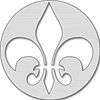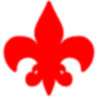Gobo (lighting)

A gobo (or GOBO) is a physical stencil or template that is placed inside or in front of a light source, to control the shape of the emitted light. They are often used with stage lighting instruments to manipulate the shape of the light which is cast over a space or object. A metal gobo with patterned holes allows only the desired shape or pattern of light through, casting a specific pattern of light and shadow into the space.
Though the term "gobo" has come to generally refer to any device which produces patterns of light and shadow, and various pieces of equipment that go before a light (such as a gobo arm or gobo head),[1] in theatrical lighting applications the term more specifically refers to a device placed in 'the gate' or at the 'point of focus' between the light source and the lenses (or other optics). This placement is important because it allows a pattern with crisp, sharp edges to be projected (for logos, fine detail, architecture, etc.). Gobos placed after the optics do not have the option of such fine focus, and are more precisely called "flags" or "cucoloris" ("cookies").
Use
Gobos may be used, in connection with projectors and simpler light sources, to create lighting scenes in a theatrical application. Simple gobos, incorporated into automated lighting systems, are popular at nightclubs and other musical venues to create moving shapes.[2] Gobos may also be used for architectural lighting, as well as in interior design, as in projecting a company logo on a wall or other feature.
Materials
Gobos can be made from various materials. Common types include steel, glass and plastic/transparency gobos.
Steel gobos use a metal template from which the image is cut out of. These types of gobos are the most sturdy of the common gobo types but often require modifications to the original design called bridging in order to display correctly. In order to correctly represent the letter "O" for example, small tabs or bridges must be made in order to keep the metal tab in the middle of the letter supported. This effect may be undesirable in more intricate patterns or designs.
Glass gobos are made from transparent glass with a partial mirror coating to block the light and produce "black" areas in the projected image. This eliminates any need for bridging, since the glass itself is the support, and allows more intricate images to be produced. Glass gobos can also include colored areas (much like stained glass windows), whether by multiple layers of dichroic glass (one for each color) glued on an aluminium or chrome coated black and white gobo, or by newer technologies that allow the thickness of the dichroic coating (and therefore the color) to be varied in a controlled way on a single piece of glass, making it possible to turn a color photo into a glass gobo. Glass gobos generally offer the highest image fidelity but are the most fragile.
Usually, to create a glass gobo laser ablation or photo etching are used.[3]
Plastic gobos or Transparency gobos can be used in LED ellipsoidal spotlights. These "LED Only" plastic gobos can be full color (like a glass gobo), but without the delicate nature. These plastic "LED Only" gobos are new to the market, as are the lights they go in, so there is much about the durability and effectiveness that will vary from brand to brand.[4]
In the past plastic gobos had been generally custom made—for when a pattern is needed in color and glass does not suffice. However, in a "traditional" (tungston/halogen) light fixture, the focus point where a gobo must be placed is usually extremely hot, so these thin plastic films generally need to be used with special cooling elements to prevent melting them. A lapse in the cooling apparatus, even for just a few seconds, can cause plastic gobos in a traditional lighting instrument to be ruined.
Patterns
A number of simple and complex stock patterns are manufactured and sold by various theatrical and photographic supply companies, or custom gobos from customer-created images can be manufactured for an additional fee. Generally the lighting designer chooses a pattern from a catalogue or small swatch book provided by the manufacturer. Because of the large number of gobos available, they are generally referred to by number, not name. For example, most manufacturers offer a gobo of a window, but they are all slightly different. So instead of calling it window, it would be identified as gobo xxxxx
Gobos are often used in weddings and corporate events to add a personal touch to the look of an event. Company logos, the couple's names, or just about any artwork can be turned into a projected image. Some companies can turn a custom gobo out in as little as a week. Common locations that custom gobos are projected in corporate/wedding situations are: the wall behind the head table, the center of the dance floor, on the floor in front of the main entrance, and the most dominant wall. "Stock" gobo patterns are also widely used for these events, often stars are water projected onto the ceiling to set a mood in the whole room.
Mechanics/optics
 |  |
| A gobo with the design on the left, with a red gel would project a pattern like the one shown to the right. | |
The gobo is placed in the focal plane of the lantern (generally an ellipsoidal reflector spotlight or a moving head). The gobo is inserted upside-down and back-to-front. The desired pattern is then projected by the lantern onto whatever surface it is pointed at such as a wall or dance floor.
Gobos can provide everything from abstract dappled light effects to complex night-time cityscapes. They are commonly used in stage lighting, television, and film production to create texture, mood, or set a scene. Specialized attachments are available to rotate multiple gobos in different directions and rates to create an illusion of motion, such as that of light reflected off of moving water.
This effect allows the lighting designer to produce effects to help portray the scene. For example, a gobo with a cloud pattern may be used to suggest a scene is outdoors.
Common sizes
| Letter Size | O.D. (mm) | I.A. (mm) | Notes |
|---|---|---|---|
| C size | 150 | 120 | |
| A Size | 100 | 75 | (ADB Europe 1000/1200W) |
| B Size | 86 | 64.5 | Standard Size for Ellipsoidal lights (Source 4, Source 4 Zoom) |
| BG Size | 79 | 64.5 | |
| M Size | 66 | 48 | (Source 4 Jr.) |
| G Size | 65.5 | 48 | For Clay Paky Goldenscans. |
| D Size | 53.3 | 38 | (Martin PR-1, EcoSpot 40) |
| Golive | 52.8 | 48 | Golive 400 |
| Cyberlight | 44.25 | 38 | |
| E Size | 37.5 | 28 | (EcoSpot 25, EcoSpot 30) |
| Studio Spot 575 | 36.3 | 31 | For HES Studio Spot 575. |
| Mac 500/918 | 27.9 | 22 | |
| Robe Color spot | 26.8 | 22 | |
| V Size | 25.5 | 22 | For HES Intellibeam 700hx |
| Mac 250 | 22.5 | 17 | |
| 518 Size | 20 | 13 | |
| O.D = Outside Diameter; I.A. = Image Area | |||

See also
References
- ↑ Box, Harry C. Set lighting technician's handbook Third Edition, Focal Press, 2003. p. 120.
- ↑ Edwin Paul J. Tozer (2004). Broadcast engineer's reference book. Focal Press. p. 516. ISBN 978-0-240-51908-1.
- ↑ Cadena, Richard (2013-05-20). Automated Lighting: The Art and Science of Moving Light in Theatre, Live Performance and Entertainment. Taylor & Francis. ISBN 9781136085260.
- ↑ King, Brian. "What is a Gobo? What types of Gobos are there?". Superlative Events. Retrieved 4 October 2013.